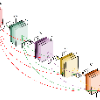Around the globe, ticks are the culprit of transmitting a variety of bacterial, viral and parasitic diseases. The incidence of tick-borne diseases has drastically increased within the last decade, with annual cases of Lyme disease soaring to an estimated 300,000 in the United States alone. As a result, more efforts in improving lesion identification approaches and diagnostics for tick-borne illnesses is critical. The objective for this study is to build upon the approach used by Burlina et al. by using a variety of convolutional neural network models to detect tick-borne skin lesions. We expanded the data inputs by acquiring images from Google in seven different languages to test if this would diversify training data and improve the accuracy of skin lesion detection. The final dataset included nearly 6,080 images and was trained on a combination of architectures (ResNet 34, ResNet 50, VGG 19, and Dense Net 121). We obtained an accuracy of 80.72% with our model trained on the DenseNet 121 architecture.
翻译:在全球各地,滴子是传播各种细菌、病毒和寄生虫疾病的罪魁祸首。在过去十年里,滴子传染疾病的发病率急剧上升,每年仅在美国就有大约300,000例莱姆病病例,因此,在改进对滴子疾病进行病害识别和诊断方面作出更多努力至关重要。本研究的目标是利用各种神经神经神经网络模型来检测滴子皮肤损伤。我们通过从谷歌获取七种不同语言的图像来扩大数据输入,以便测试是否使培训数据多样化并提高皮肤损伤检测的准确性。最终数据集包括近6,080个图像,并经过综合结构培训(ResNet34、ResNet 50、VGG 19和Dense Net 121)。我们用在DeneNet 121结构上培训的模型获得了80.72%的准确率。




